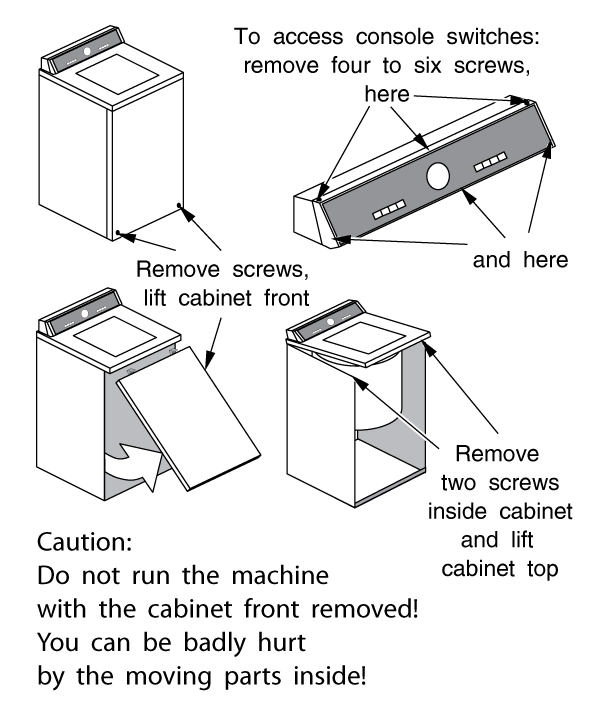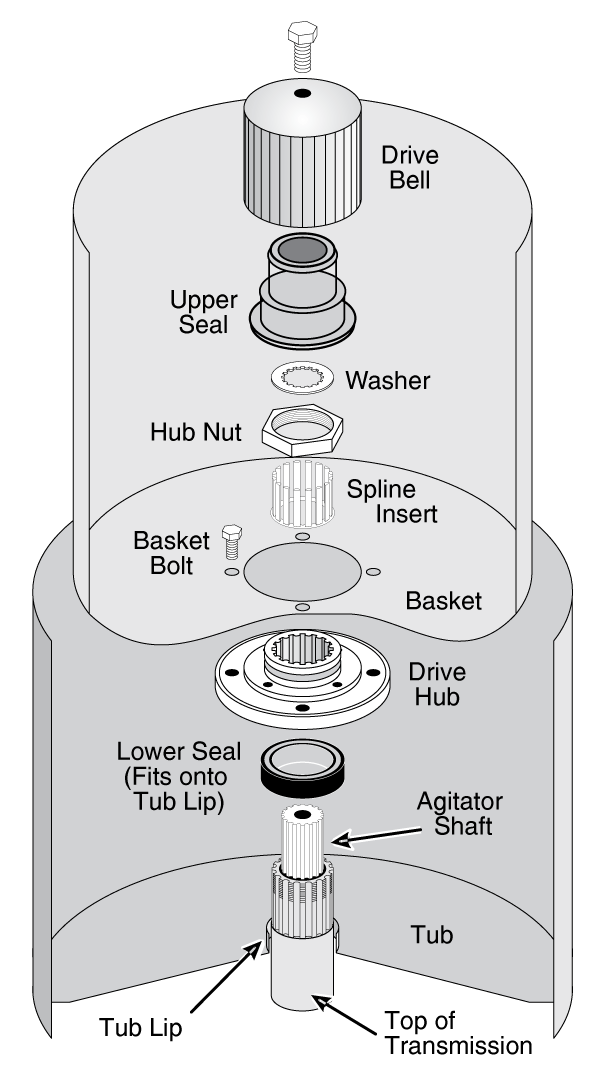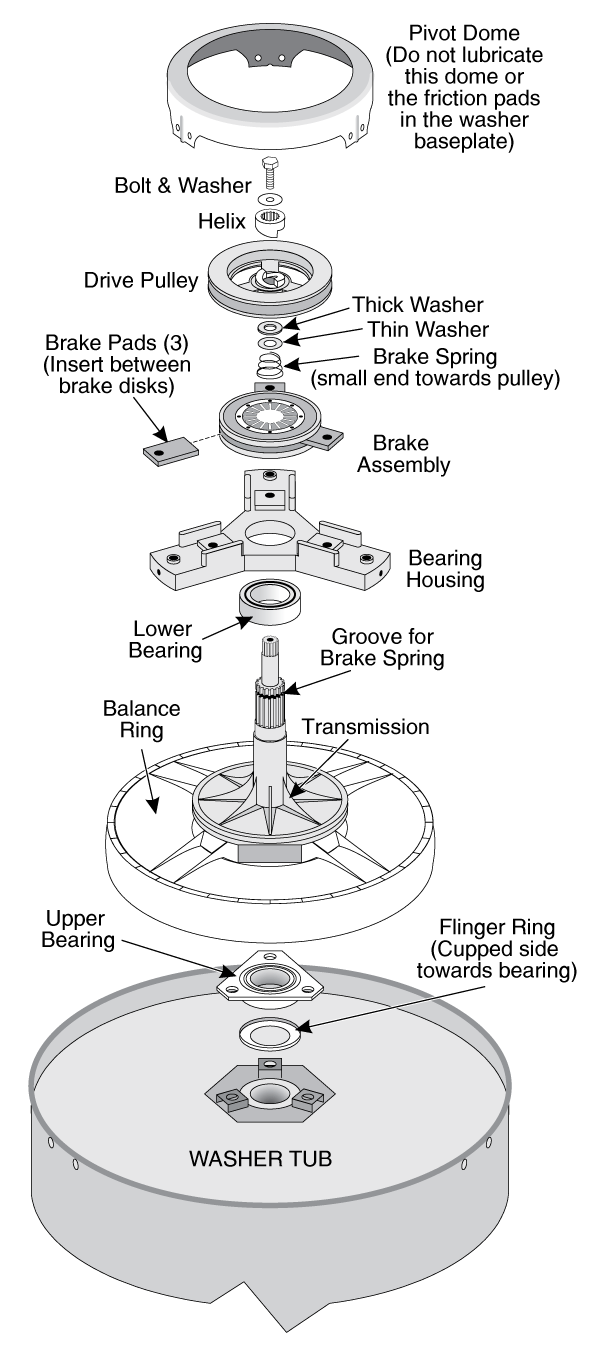Washing Machine Repair
NOTE: Chapter 2 covers problems common to almost all washer designs.
THIS chapter covers only diagnosis and repairs peculiar to late
model Speed Queen / Amana-designed washing machines.
If you do not read Chapter 2 thoroughly before you read this chapter,
you probably will not be able to properly diagnose your machine!!!!
Speed Queen washing machine has undergone several major design changes in the past few years. Parts for the old (pre-1980) fluid drive machines are generally not available anymore, and they are no longer economical to repair, so they are no longer included in this manual. If you have one of these fluid-drive machines, you'd best be thinking about getting a new machine.
Raytheon / Amana is notorious for making several design changes even within a single model year. When ordering or buying parts, it is wise to bring with you the production number, found on the nameplate along with the model number. Might save you a trip.
Even among the new style washing machines, there have already been two MAJOR design changes. Inside the tub, they went from the old-style agitator post and drive block (similar to those found on the old fluid drive machines) to a short-shaft air-bell agitator connection. (See section 8-5) Later, they went from a pump driven by a second belt to one mounted directly on the drive motor.
Late model washing machines have a direct-reversing motor, and the transmission is belt-driven directly off a motor pulley. (Figure SN-1) Until the early '90's they used a second belt to drive the pump; these are commonly referred to in the parts stores as "two-belt" machines. After that, the pump was driven directly off the bottom end of the motor shaft; these are commonly referred to as "direct drive" washing machines. There is only one belt in direct drive machines.

The top of the transmission casing is connected to the basket, and during the spin cycle, the whole transmission rotates. Slippage in the belt, allowed by the tensioner, permits a "pre-pump" action, allowing the basket to come slowly up to speed.
The bottom of the transmission casing is connected to a brake. This brake is activated by a helix in the hub of the transmission pulley. During the agitate cycle, the brake engages and prevents the transmission casing (and thus the basket) from turning. During the spin cycle, the helix mechanism releases the brake and the whole transmission spins around.
The console or cabinet may be opened as shown in figure SN-2.

CONSOLE SWITCHES
The timer knob simply unscrews from the timer shaft. Most other knobs pull straight off their D-shaped shafts. The timer and most other switches can then be removed by opening the console and removing the switches' terminals and appropriate mounting screws or nuts.
However, some switches on late model machines are different. To remove them from the console, you must press on the locking tabs adjacent to the shaft (figure SN-3) and twist the whole switch counterclockwise.

The most common problems with these washers are:
SYMPTOM: WATER LEAKS
In "short shaft" machines (late model machines with a drive bell; see section 8-5) the center tub seal starts leaking. To repair or replace, see section 8-6.
Another source of water on the floor is pump leaks. To replace, see section 8-4.
The basket may be spinning during agitation. This will sling water over the top edge of the tub and appear to be a water leak. Replace the brake pads as described in section 8-7.
SYMPTOM: NOISY OPERATION
In my opinion, these machines operate a little noisily to begin with. However, if they seem a little noisier than usual, check your belt(s). The sound is difficult to describe; it's kind of a "thunk-thunk-thunk." It happens when the belt has a few chunks taken out of it; the belt tensioner/idler starts "bouncing." To check and replace the belt, see section 8-4.
A "knocking" sound during agitation may be a worn drive block. See section 8-6.
SYMPTOM: OIL IN THE CLOTHES
If oil starts showing up in the clothes, what has usually happened is that the top transmission seal has deteriorated and is letting water into the transmission casing. The water displaces the oil and forces it out through the seal and into the clothes.
If you want to keep the machine, the transmission must be replaced. This is a difficult and expensive repair, often costing more than 200 dollars just for parts. You may want to price out the job before you start and decide whether it might be more worthwhile to just replace the machine. You might also check out the availability of a rebuilt transmission. See section 8-7.
SYMPTOM: NO AGITATE, OR NO SPIN
This is usually a broken transmission drive belt. (Section 8-4) It could also be a defective drive motor. (Section 2-6(e)) or a siezed pump, preventing the motor from turning.
(Figure SN-4)
Pumps in the late model machines cannot be rebuilt. They must be replaced if leaking or defective.
TWO-BELT MACHINES
Belt driven pumps are replaced by simply removing the pump mounts.
Tension is kept on the pump belt by adjustment. Tension is kept on the transmission belt by an idler pulley. There is a kit available from your parts dealer with a new belt and idler and instructions on how to adjust the belt.

In two-belt machines, you can adjust the pump belt by loosening the pump mounting plate bolts and moving the pump until you have about 1/2-inch deflection with moderate finger pressure (about 1 to 2 pounds.)
DIRECT DRIVE MACHINES
Pump or belt changing on a direct drive machine is a little trickier. To do either the pump or belt, you must remove the motor platform. First, unplug the motor electrical harness block from the motor. Release belt tension by slipping the belt off the transmission pulley. Disconnect the hoses from the pump. (Water will run out, so have a towel handy!) You can then remove the four motor platform mounting screws, and rock the motor and pump assembly out. When you get it out, flip it upside down to work on the pump. (Figure SN-5)

Remove the screws mounting the pump to the motor. Sometimes the pump can get siezed up pretty good on the motor shaft and make the pump difficult to remove. Do not whack it; steady firm musclepower will get it off. Wiggle it just a little if you must.
When you put the new pump back on the motor, make sure the belt goes around the pulley and straddles the rear pump mounting leg. (Figure SN-5) Attach the motor platform to the baseplate using the four motor mounting screws. Make sure the belt is positioned inside the idler, and slip the belt around the transmission pulley. Then connect the hoses and motor wiring harness.
Please note that two different methods were used to mount the agitator in these machines. Please read this entire section and determine which you have before trying to remove the agitator, or you may damage the machine, or even yourself!
EARLY TWO-BELT "LONG-SHAFT" MACHINES
The early two-belt machines had an agitator post and drive block. (figure SN-6) In these, you remove the agitator by unscrewing the hold down cap and lifting it out. You must remove the whole agitator post to get out the agitator shaft and drive block. (Figure SN-7) Remove the four bolts at the base of the agitator post and lift out the post. A circlip on the bottom of it holds the shaft in place. Remove it and the shaft will slide out of the post. Be careful not to damage the water seal inside the post when removing or installing the shaft.
When installing the post, be sure to use a new base gasket; it is one of the seals that keeps water away from the top of the transmission.


DRIVE BELL OR "SHORT SHAFT" MACHINES
In later machines, the agitator simply snaps onto a "drive bell." There is no screw cap holding the agitator on in these machines. To remove this agitator, the factory recommends a special tool. I have found it just as easy to take your belt off, slip it around the underside of the agitator and tug sharply upwards on the belt. (If you're thick enough, like me!) (Figure SN-8) Position the belt beneath the agitator vanes to avoid breaking the agitator. Be careful when you do this, or the agitator may hit you in the face when it pops off!

Once you've got the agitator off, you'll see the small plastic drive bell. (figure SN-8) This drive bell serves a couple of different functions. It connects the agitator to the agitator shaft of the transmission. It also traps air beneath it and keeps water away from the seal and out of the transmission. There is an "O"-ring around the drive bell mounting screw, and/or a rubber plug that plugs the top of the drive bell, that seals the air inside the drive bell. It is critically important that this "O"-ring or plug be in good condition or water will get into the transmission and ruin it. Whenever you remove the drive bell screw, replace the "O"-ring or plug.
Once you remove the mounting screw, the drive bell can be difficult to get off. If you can't get it off by hand, you have a couple of options. The factory sells a special puller; however, since a new drive bell comes with the seal kit, I've found that it's cheaper and easier to chisel off the old drive bell. With a cold chisel, just cut two slots along the hub of the drive bell to loosen it from the splined shaft beneath. Be careful not to chisel anywhere near the screw threads, or you might damage them.
Beneath the drive bell is a water seal. To remove it, pry up on the bottom of this seal with a screwdriver. The factory has a special tool to install it evenly, but if you're careful, you can do it by hand. Use some liquid dishsoap to lubricate it. The new seal kit comes with pretty thorough instructions.
If you are replacing the tub water seal, make sure you get the upper seal kit and replace it, too. It may be included with the lower seal kit; just make sure it's there.
First, remove the agitator and agitator post assembly, or the drive bell and seal, as described in section 8-5. Using a screwdriver, pop the tub ring clips holding the plastic tub ring to the top of the tub, slowly lifting up on the tub ring as you work your way around it. Remove the tub ring. Note the locator tabs in the ring and slots in the tub for reinstallation. Always replace the tub ring gasket; it should be included in your new seal kit.
If you just want to check the tub fittings, remove the four (or eight) basket bolts holding the basket to the drive hub and lift out the basket. Do not remove the hub nut.
If you are replacing the tub water seal, you will need to remove the drive hub. The hub is held onto the top of the transmission casing by either a hex nut or a spanner nut. Some have locking tabs you must bend out of the way first. You should then be able to turn the nut. There is a spanner available for this, but you can use a pipe wrench. Just be extra careful not to booger the threads with the pipe wrench; these threads are cut into the top of the transmission casing, and you don't want to have to buy a new transmission.
The water seal is beneath the drive hub. Note carefully the order and orientation in which things come off; there are some models out there with an parts that are slightly different than shown in Figure SN-9. Always replace used gaskets or seals.

There are a couple of surfaces to put sealant and lubricant on in replacing the water seal; the seal kit contains these. There is also a spline insert and a stainless steel sleeve to get in the right place. (The fingers of the spline insert point upwards!) The new hub and seal kit for your machine comes with instructions for installing the seal; follow them carefully.
If you just need to replace the brake pads, it is possible (but difficult!) to do so without removing the module from the machine. The problem is holding the transmission and getting a good grip on and turning the pulley at the same time; once the brake starts to release, the transmission will be free to turn. Then once you get the brake released, the problem becomes holding it in that position while you replace the brake pads. If you're going to try, make sure you remove the motor platform first to get more room to work.
If you need to replace the transmission or brake disk assembly, or the upper or lower bearings, you will need to remove the tub and transmission module.
To do this, first remove the wash basket, hub and tub water seal as described in previous sections.
Mark the front side of the tub with a piece of tape, so that you can reinstall it more easily. Remove the two front levelling springs by unhooking them from the tub. The factory sells a tool for releasing the springs, but you can fashion one out of a coathanger, or simply remove one of the front springs and use the hook on it to remove the other springs.
When you've got the springs off, disconnect the pressure hose from behind the tub. Rock the tub forward and out of the machine and flip the module upside down.
(Note: DO NOT lubricate the pivot friction pads! Any lubrication on the friction pads will cause the machine to trip the out-of-balance switch too easily!)
Disassembly of the module is pretty straightforward; see figure SN-10. However, there are one or two tips and tricks:

The brake spring must be seated in the notch in the transmission casing. The factory makes a special tool for this; however, it is possible (but difficult) to get the spring on with a couple of flat-bladed screwdrivers. It's your call. I say buy the tool if it's available.
Coat all transmission surfaces that contact the upper and lower bearings with an anti-sieze compound. Make sure you mark the position of the balancing ring when you remove it from the transmission, so that you can get it back on the new transmission in the same way.
NOTE: Module assembly is pictured upside-down; this is the way you will have it when disassembling it!
ALSO NOTE:
There were many different washing machine models made of this basic design! Some had variations of the parts you see here. For example, in some earlier models, a needle bearing was used in place of the thick and thin washers. In others, a cup-shaped drive pulley was used. When disassembling, Note carefully the order and orientation of the parts you remove (draw pictures or take notes if you must!) so you can get them back on the same way.
Please share our .